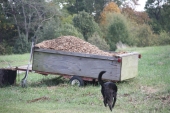

 6
6




Works at a residential alternative high school in the Himalayas SECMOL.org . "Back home" is Cape Cod, E Coast USA.
 7
7




Some places need to be wild









Eric Hanson wrote:... I was told that earthworms would eat mycelium. After a bit of research I can safely say that this is not true.
Works at a residential alternative high school in the Himalayas SECMOL.org . "Back home" is Cape Cod, E Coast USA.
 2
2




Carla Burke wrote: Hi, Eric! Well.... I suppose you could plant sorghum, in the spring, harvest it, make your own blackstrap, and go from there. It would take another year, but it could absolutely be done.
 4
4




Some places need to be wild
 3
3




Have you considered throwing any old, heat-loving seeds in that bed and letting them fight it out? If nothing else, you might get organic matter to chop and drop, and at least there will be lower odds of "weeds you don't want" moving in?In my bed #3, I will likely grow nothing this year owing to my very late start.
Visit Redhawk's soil series: https://permies.com/wiki/redhawk-soil
How permies.com works: https://permies.com/wiki/34193/permies-works-links-threads
 1
1




Some places need to be wild
 1
1




Some places need to be wild
 4
4








Some places need to be wild
 2
2




I suggest you take as much advantage of a chip source as you can while you can get them. In my area, everyone's figured out how useful they are, and you're lucky if you can get a single load and certainly not the multiple loads I was able to get years ago.Eric Hanson wrote:Also great that you have secured yourself a long-term source of wood chips. I still have to chip mine up and while I like the project, it can be quite a workout.
Visit Redhawk's soil series: https://permies.com/wiki/redhawk-soil
How permies.com works: https://permies.com/wiki/34193/permies-works-links-threads
 2
2




 4
4




Some places need to be wild
 1
1




Some places need to be wild




 1
1




Some places need to be wild
















Some places need to be wild




 1
1




Do you know if you can use hay instead? Hay is much easier to find in my neck of the woods! I forgot - do you mix the hay with wood chips or do it in layers?I have found that straw is like kindling for the fungal fire—it starts fast, gets growing very quickly, spreads well to wood but doesn’t last well by itself.
Visit Redhawk's soil series: https://permies.com/wiki/redhawk-soil
How permies.com works: https://permies.com/wiki/34193/permies-works-links-threads




 2
2




Some places need to be wild




Some places need to be wild
 1
1




 2
2




Some places need to be wild
 1
1








Some places need to be wild
 1
1








Some places need to be wild




Visit Redhawk's soil series: https://permies.com/wiki/redhawk-soil
How permies.com works: https://permies.com/wiki/34193/permies-works-links-threads




 1
1




Some places need to be wild
 2
2




I know the feeling of "tiny" batches. I use a stainless food warming tray with a lid on it inside our wood stove. You have to get one that fits with space around it for the fire, and Hubby usually has a small fire and then builds it up adding the covered tray with fresh wood around it. We can take it out and put it somewhere safe to cool (concrete usually), water it down often adding a little liquid gold, and then it goes into the compost, as Eric suggested. If I lose a bird, I wrap it in an old feed bag with the fresh char around her, and that gets buried in the compost also. It's *very* small scale, but every little bit helps! During our droughts, many locals water their veggies daily if not twice a day. I water mine every 2-3 days and not near as much water as most would use. I believe it's the combination of punky wood, compost with biochar, polyculture veggie patches, and supporting the local mushrooms, even if I haven't tried intentionally growing any yet. There's a local edible one I recognize and when I see it fruiting, I often try to move it somewhere I hope it will like living. I think it likes to be under fir trees, so it may not be willing to hang out in my veggie beds, but I do give it the opportunity to try!Eric Hanson wrote:If you want to make Biochar, I could walk you through some ways to make it. I have dabbled in char in the past with fairly good results but my batches were tiny.
Visit Redhawk's soil series: https://permies.com/wiki/redhawk-soil
How permies.com works: https://permies.com/wiki/34193/permies-works-links-threads
 2
2








Some places need to be wild




It teaches them humility and that the world isn't going to be perfect!Eric Hanson wrote:And yes, absolutely, embarrassing our children is TOTALLY the job of parents!
Visit Redhawk's soil series: https://permies.com/wiki/redhawk-soil
How permies.com works: https://permies.com/wiki/34193/permies-works-links-threads

|
a short history of short ads:
Uncle Mud's EZ Cob Rocket Stove
https://permies.com/t/106214/Uncle-Mud-EZ-Cob-Rocket
|




